Pride Month 2023, Brands Changed LOGOs to support LGBTQIA+
Recently, I noticed that some enterprise logos on LinkedIn have changed slightly. Upon clicking on their profile pages, I discovered that June is Pride Month, and these enterprises have incorporated a rainbow theme in three ways:
- Redesigning their logos with rainbow elements
- Changing the banner of their profile page
- Publishing posts on Pride-related topics
After browsing LinkedIn freely and collecting over 300 logos to create a mini dataset on Notion, some interesting insights have emerged.
Notion Dataset: https://dongou.notion.site/1f26ed07c9c84bc69c56447b9d989115
Figma File: Pride Month 2023 – 270+ Brand LOGOS, https://www.figma.com/community/file/1249806342143175407
Two factors contribute to the potential bias:
- Incomplete data coverage due to limited sampling. Not all companies and industries were viewed, and the sample may not be representative or sufficient.
- The platform DNA of LinkedIn is an employment-focused social media platform. Some enterprises may only use it for hiring purposes without actively engaging in social activities.
1. Who
1.1 industries
1.1.1 Silent
These enterprises are from various industries, but there is a clear industry bias on the LinkedIn platform.
Despite the fact that we would expect the media/TV industry to be the most active in promoting “Pride Month,” after viewing the profile pages of well-known media outlets such as BBC, The New York Times, Forbes, and others, they seem to be quite quiet. Is LinkedIn, not their main social or publicity platform?

The fashion industry, whether luxury, apparel, or jewelry, often seems like a stagnant pool. There is a close relationship between fashion and the LGBTQIA+ community, with many LGBTQIA+ designers and customers in this field. However, despite the fact that many brand founders are LGBTQIA+, they remain silent. At present, I only discovered that Swarovski changed its logo to support Pride Month. It is difficult to determine whether this is due to a desire to maintain the brand’s high-end luxury image and VI/CI or for some other reason.
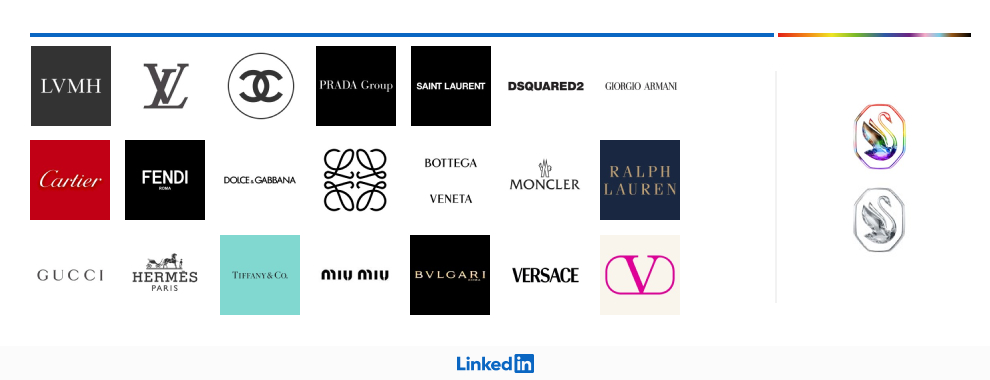
Meanwhile, fashion+ media, the well-known fashion magazines remain quiet.

Many personal care brands do not have a LinkedIn account. Instead, their job postings are published through group accounts such as P&G, Unilever, L’Oréal, Shiseido, and Estée Lauder. However, only L’Oréal has changed its logo.
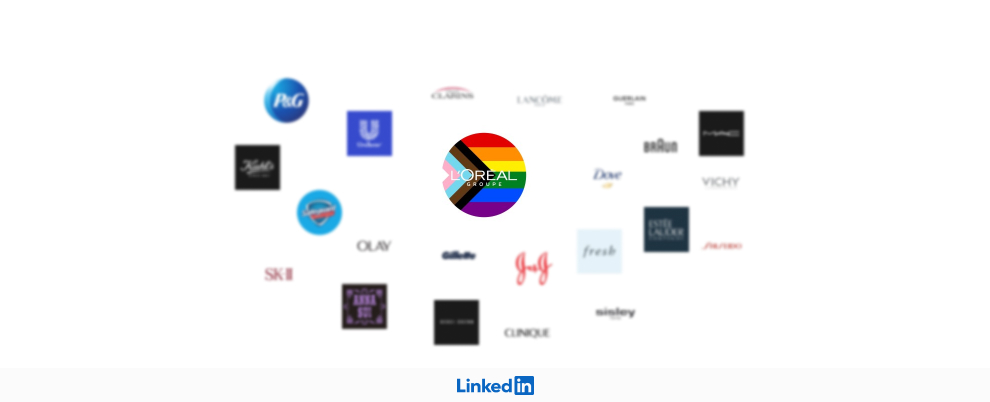
Tech giants such as Microsoft, Apple, Meta, and Google have huge business landscapes with their products all over our lives. with their products all over our lives. Even the hottest AI start-ups in 2023, OpenAI and Anthropic, seem to have done little to support Pride Month on LinkedIn. Do tech/IT companies pay no attention to it? IBM, SAP, Cisco, and many other tech/IT SMZs have changed their logo. Why? Do these famous brands have strict VI/CI rules that limit their expression? It’s very confusing.
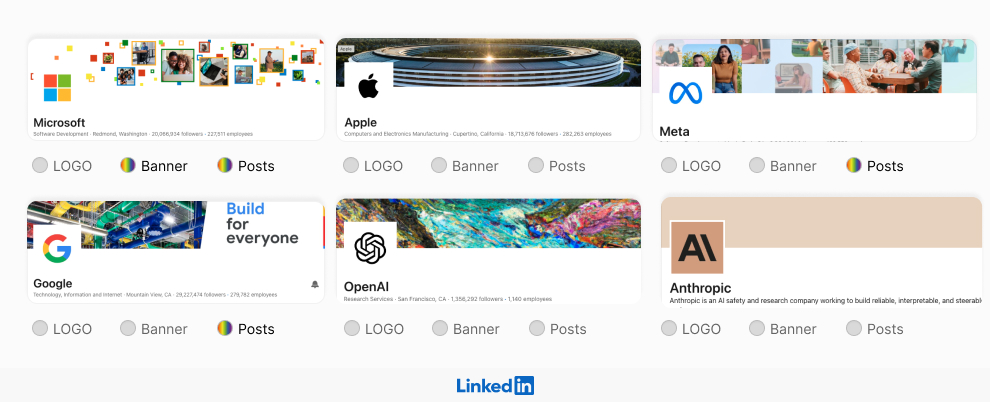
1.1.2 Loud
The pharmaceutical, chemical, and biological industries are almost fully mobilized for Pride Month, with giants such as Roche, Pfizer, Merck, Sanofi, BMS, Bayer, and Astellas changing their logos to show support.
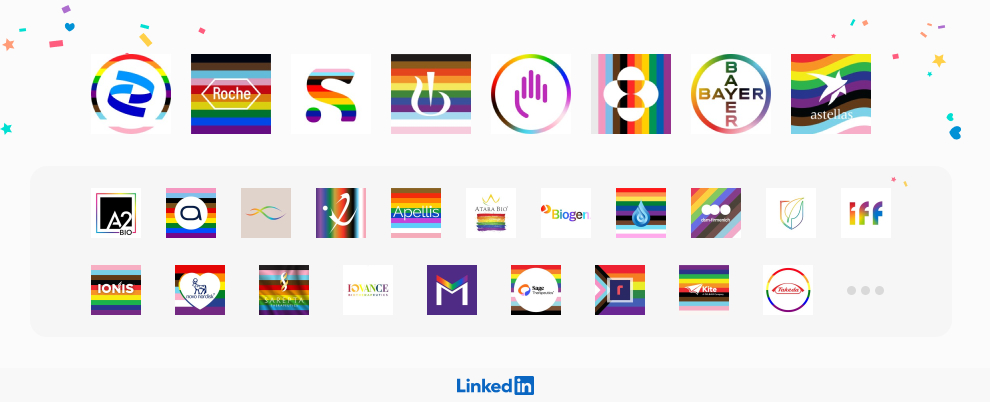
But why? After searching online, an old article from the New York Post provided some interesting insights:
“Lupron manufacturer AbbVie made $726 million on the drug alone in 2018. AbbVie has joined other major pharmaceutical companies in lobbying to keep drug prices high while virtue-signaling about diversity and inclusion.
Transgender people require lifelong medical support, making them ideal customers for the health-care industry, and the well-documented phenomenon of “peer contagion”—kids pressuring each other into thinking they’re all trans — ensures an endless supply of consumers.” – Gender ideology is a boon to Big Pharma and threat to parental rights (August 20, 2021)
Is it all business?
Meanwhile, the Business Consulting industry is all-in too, with almost all of the Top 20 companies changing logos in June 2023. who are they changing for? Their customers are enterprises that are not high-frequency users of LinkedIn, so who is this for?
- Employees and job seekers, to demonstrate corporate cultural diversity?
- Enterprises and management, to demonstrate their sensitivity and responsiveness to current events?
- Or is it for other reasons?

1.2 Region and country
In the mini dataset, there are almost European and American brands. During viewing on LinkedIn, I found some brands have multiple country and regional accounts. Many of them did not change their logos, especially Asia and Middle East accounts, but the India account is an exception.
For example, Mercedes-Benz:
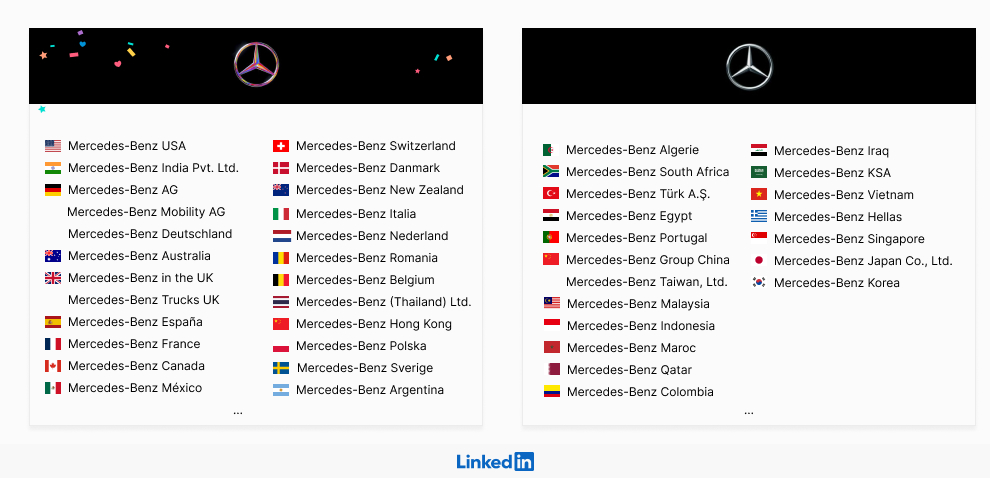
The brands pays great attention to respect the culture and religion of various countries, and business is the most important thing.
2. HOW
Brands have guidelines and requirements for logo usage to manage and protect their brand value. These guidelines often include specifications regarding color, elements, sizing, scaling, and other aspects. However, for Pride Month, these rules appear to be disregarded as logos are modified in various ways to incorporate the rainbow theme.
2.1 Color
Pride Month, it’s a rainbow world. When examining logo images, it becomes evident that they utilize different color spectrums. The colors used in these logos vary in terms of their numerical values and may not adhere to a consistent rainbow color pattern.

Why? Does color come from the Pride Flag? After searching, you found that the explanation is not as simple as you initially thought.
So I created another online dataset on Notion to explore different Pride Flags and their variations:
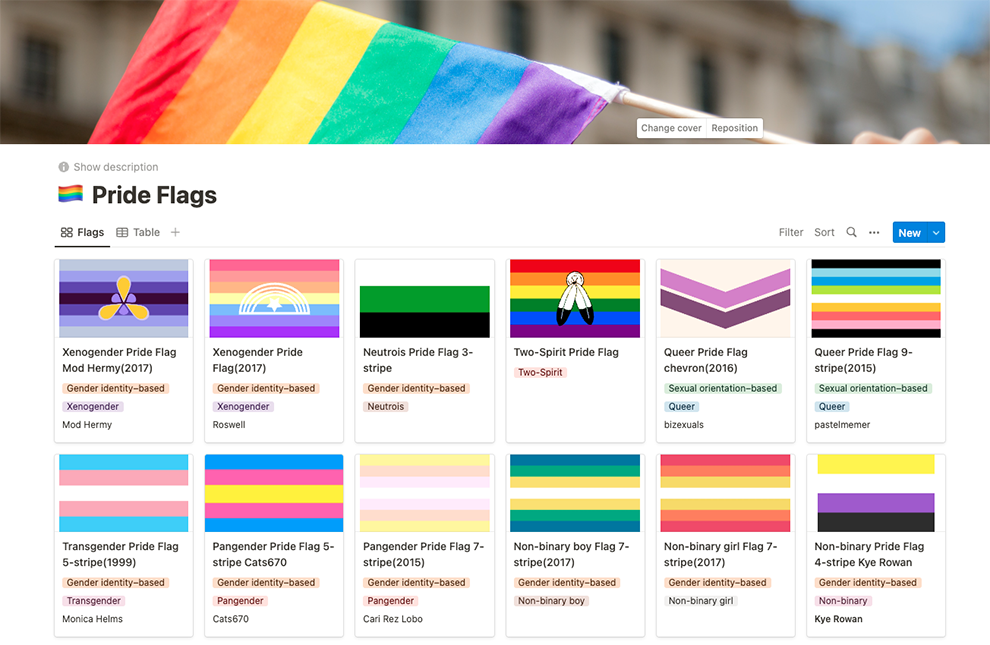
Notion Dataset: https://dongou.notion.site/bbe4075001a841ddae08618a744ee419
Figma File: Pride Flags 2023 beta, 150+ flags, https://www.figma.com/community/file/1251158401988564023
Numerous variations of Pride flags and user-designed flags incorporate a non-standardized color system. Logos are modified freely using gradient colors, color stripes, blurred backgrounds, and other elements to create a rainbow-like appearance.
2.2 Transformation
Logo transformations for Pride Month can be categorized into three main types: fully changed, semi-changed, and adding elements.
2.2.1 Fully changed
Completely do not consider the specification of the logo, change the standard color and graphic structure of the brand logo.

2.2.2 Semi-changed
In the semi-changed type of transformation, the logo retains its core elements and structure. They used the reverse version logo(logotype in white) or the positive version directly on rainbow backgrounds(Pride flags, color stripes, and so on).
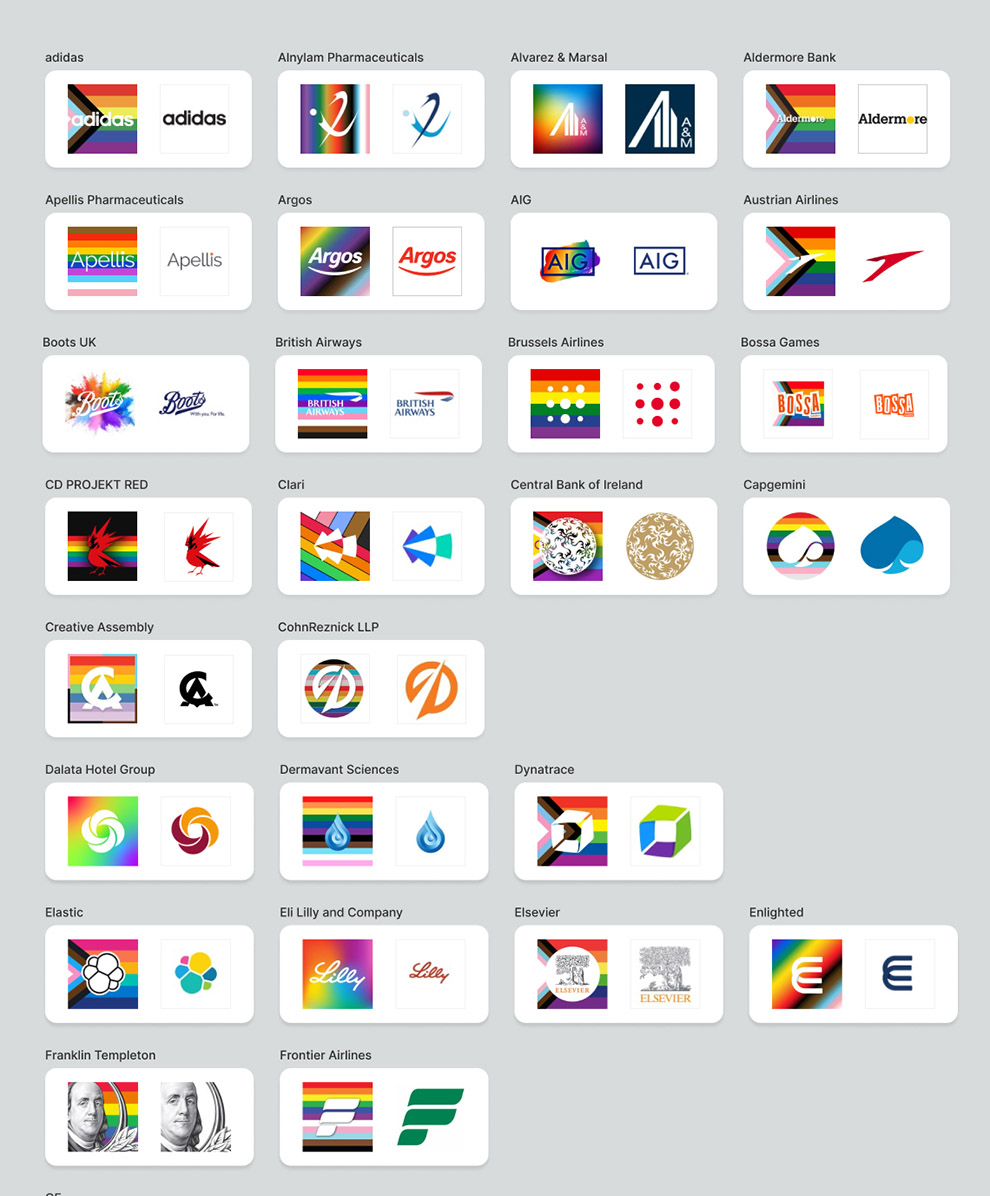
2.2.3 Adding elements
Adding elements involves scaling the existing logo and incorporating rainbow elements while maintaining the overall color and graphic structure of the brand logo. This approach allows the logo to retain its original identity while symbolizing support for Pride Month.

P.S.
Brands also changed LOGOs for Pride Month on other social platforms, including Twitter, Facebook, YouTube, and more. However, there are slight differences in the way these platforms display logos. For instance, Twitter typically uses a circular layout for the profile image, while LinkedIn uses a square layout, resulting in design variations.
3. WHEN
As of June 18, 2023, some brands have reverted to their original logos. It’s difficult to track their dynamics on LinkedIn. However, turning to Google Trends, there may be interesting insights that can be reflected indirectly.
3.1 Trending now (2023/05/01-now)
Setting searching terms: Pride Month, Pride Flag, LGBT(LGBTQ, LGBTQIA)
Pride Month: Thu, Jun 1, 2023 – Fri, Jun 30, 2023
Except for “LGBTQIA,” other terms experience fluctuations in search interest between May and June, reaching their peak on the 1st of June. However, their interest quickly diminishes afterward. Particularly, the term “Pride Month” shows a sharp fluctuation. On the first day of June, “Pride Month” captures the attention with a flood of celebratory information. The high search interest on the 1st of June suggests that “Pride Month” sparks curiosity and intrigue among people. However, interest declines the following day.
On the other hand, the term “Pride Flag” exhibits a relatively stable fluctuation, also reaching its highest value on the first day. This pattern can be attributed to the presence of various pride flags displayed in streets and in news pictures. People are inclined to search for the meaning of these flags or add them to their social platforms as a way of expressing their participation in the pride event.
Comparing the terms “LGBT,” “LGBTQ,” and “LGBTQIA,” it appears that “LGBT” has a higher average search interest compared to the others. People are generally more familiar with the “LGBT,” while the other terms are not as widely known, particularly the latest term “LGBTQIA”.
Google Trend: Numbers represent search interest relative to the highest point on the chart for the given region and time. A value of 100 is the peak popularity for the term. A value of 50 means that the term is half as popular. A score of 0 means that there was not enough data for this term. Note: A higher value means a higher proportion of all queries, not a higher absolute query count. So a tiny country where 80% of the queries are for ‘bananas’ will get twice the score of a giant country where only 40% of the queries are for ‘bananas’.
By Region
Pride Month is indeed widely celebrated in the West and also gaining recognition in some Asian countries like Thailand. However, it is interesting to note that in China, only the term “LGBTQIA” had a search interest value of “50.” The specific reasons behind this observation can be challenging to determine without further context or data.
3.2 2004 – present
Search Term: Pride Month
The term “Pride Month” experiences fluctuations each year in June. It appears that Pride Month primarily captures people’s attention during the initial few days, despite being a month-long event. Before 2021, the trend was on an upward trajectory. However, in 2022, it experienced a decline, but there are indications of a potential recovery in 2023.
Finally, I hope Pride Month does not turn into a marketing or political gimmick.